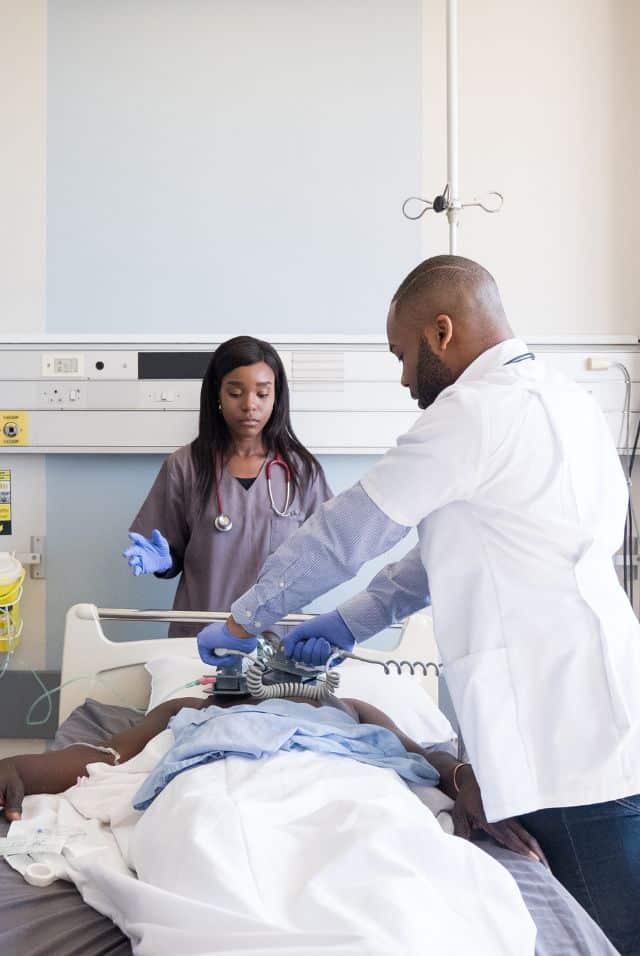What is a Defibrillator – Overview
A defibrillator is a medical device that provides an electric shock to your heart so it can adjust its abnormal rhythm (arrhythmia), which can often be otherwise fatal.
This device is also used in the event of ventricular fibrillation and ventricular tachycardia. Both these problems develop in the ventricles, the two lower chambers of the heart.
Who Can Use a Defibrillator?
Anyone suffering from arrhythmias can use a defibrillator at a hospital or place that has an automated external defibrillator available. However, if you have a high-risk arrhythmia, then you may need to get your defibrillator.
A shock from a defibrillator can be quite forceful and is often described as feeling like a kick to the chest. People who suffer from potentially fatal arrhythmias can use the following types of personal defibrillators:
Wearable cardioverter defibrillator – This is an externally-worn device that can be used like a vest under your clothes. The sensors in the device are kept in contact with your skin so they can detect an abnormal rhythm and send an electric shock to get the heartbeat under control.
Implantable cardioverter defibrillator – This device is implanted near the collarbone with leads running to the heart, not specifically to the main arteries. It monitors the heart rhythm and delivers electric shocks or pacing to correct arrhythmias when necessary.
The defibrillator part kicks in when the sensors detect an abnormal rhythm and send an electric pulse to adjust the heart rate to normal levels.
How Does a Defibrillator Work?

A defibrillator often proves essential to survive a sudden cardiac arrest, as CPR (cardiopulmonary resuscitation) provides only temporary relief. A person who already has a pacemaker or an ICD implanted can also use a defibrillator.
In the event of sudden cardiac arrest, it is advisable to keep providing CPR to the patient until you have access to a defibrillator.
Once you have the defibrillator in hand, make sure to shock the patient when no one is touching the patient’s body or bed.
Using an automated external defibrillator (AED) can also check the heart’s rhythm and determine if an electric shock is needed. Once the AED gets fully charged, it also gives verbal instructions and warnings on how to use it.
Usually, a defibrillator is used by a healthcare provider or first responder in the following manner:
- Place the two sticky pads or paddles connected to the defibrillator on the patient’s chest. One paddle/pad should be placed just below the right shoulder, and the other pad/paddle should be placed carefully below the left nipple. A special conducting material is applied to the pads/paddles of a defibrillator to prevent burns. Still, you will need to put conducting material on the patient’s chest before using the paddles/pads.
- You must push a button on the defibrillator machine for sticky paddles to give the shock. For handheld devices, you must push the button on each paddle simultaneously.
A defibrillator delivers an electric shock to the heart that briefly stops an abnormal rhythm, allowing it to spontaneously establish a normal rhythm.
What Happens After Using a Defibrillator?
Initially, the first responder or healthcare provider will give the patient CPR for around two minutes. Then, they will check the patient’s pulse and see if the heart rhythm is normal. If needed, they will give more CPR and another electrical shock.
If defibrillation does not work successfully, the first responder or healthcare professional will administer medication, such as amiodarone or epinephrine, to correct the abnormal rhythm.
If the blood flow is normal, but the patient is non-responsive, the healthcare professional will attempt to bring the patient’s body temperature down to 89.6 to 96.8 degrees Fahrenheit (32 to 36 degrees Celsius) to protect and promote recovery of brain functions.
Once the patient’s condition is stabilized, the healthcare provider may perform a cardiac catheterization.
What are the Benefits of using a Defibrillator?
A defibrillator is primarily used for life-threatening arrhythmias such as ventricular fibrillation or pulseless ventricular tachycardia. It is not typically used for other arrhythmias where a pulse is present, as the device is designed to correct specific life-threatening conditions.
Recovering after defibrillation following a cardiac arrest is a long-term process. Depending on the patient’s age, medical history, lifestyle, and other factors, it may take several months to a few years.
Post-cardiac arrest syndrome can include a range of physical, cognitive, and emotional symptoms, affecting survivors to varying degrees. The percentage of survivors experiencing significant impairments that prevent them from resuming work or regular activities varies widely and depends on numerous factors, including the severity of the cardiac event, the quality of immediate care, and the rehabilitation services available.
It may take considerable time to recover from a rib fracture that may happen during CPR and to manage other related problems, such as difficulty in walking or seizures. You may need to undergo physical, speech or occupational therapy to recover from defibrillation.
Conclusion
If you see someone collapsing with chest pain, it is advised to immediately call the emergency medical services (EMT) number. if you are trained in CPR, then you may administer it, at your discretion.
However, it is always advisable to make the patient feel comfortable until the professional EMTs arrive and take charge.
See Also
American Heart Association AED Grants
AED Grants for Police Departments